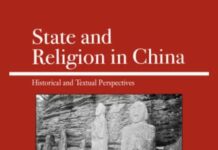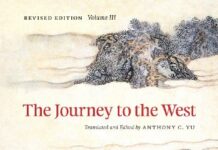
Ebook Info
- Published: 2008
- Number of pages: 514 pages
- Format: PDF
- File Size: 27.54 MB
- Authors: Anthony C. Yu
Description
Anthony C. Yu’s celebrated translation of The Journey to the West reinvigorated one of Chinese literature’s most beloved classics for English-speaking audiences when it first appeared thirty years ago. Yu’s abridgment of his four-volume translation, The Monkey and the Monk, finally distills the epic novel’s most exciting and meaningful episodes without taking anything away from their true spirit. These fantastic episodes recount the adventures of Xuanzang, a seventh-century monk who became one of China’s most illustrious religious heroes after traveling for sixteen years in search of Buddhist scriptures. Powerfully combining religious allegory with humor, fantasy, and satire, accounts of Xuanzang’s journey were passed down for a millennium before culminating in the sixteenth century with The Journey to the West. Now, readers of The Monkey and the Monk can experience the full force of his lengthy quest as he travels to India with four animal disciples, most significant among them a guardian-monkey known as “the Great Sage, Equal to Heaven.” Moreover, in its newly streamlined form, this acclaimed translation of a seminal work of world literature is sure to attract an entirely new following of students and fans. “A new translation of a major literary text which totally supersedes the best existing version. . . . It establishes beyond contention the position of The Journey to the West in world literature, while at the same time throwing open wide the doors to interpretive study on the part of the English audience.”—Modern Language Notes, on the unabridged translation
User’s Reviews
Reviews from Amazon users which were colected at the time this book was published on the website:
⭐This is a distillation of Yu’s faithful translation of the 100 chapter, 4-volume The Journey to the West, the part historical, part mythical epic of Chinese literature which has been the basis for numerous movies, animes. and memes. The essential first 8 chapters of the original, which tell how Monkey becomes a force to be reckoned with, are condensed to 7; most of the trimming comes after the divine monk Tripitaka Tang sets out to bring Buddhist scriptures from India back to China, since his encounters with obstacles become a bit repetitive in the long version.The monk is actually the incarnation of a Heavenly being who volunteered to suffer human birth in order to bring the means of enlightenment to the people of the East. But once he is mortal he will lose his divine perceptions and be vulnerable to illusions, deceptions, and wrong thinking, so he is assigned 4 assistants, all of them immortals who have fallen into disgrace one way or another. (Don’t drop a teacup or set fire to Heavenly curtains, and especially don’t steal all the peaches.) Their task is to transport him safely, thereby winning their freedom to return to their former estates. This assignment is made difficult by several factors. At least two of the disciples loathe each other and are forever squabbling and fighting. Pigsy is lazy and wants to go back to eating meat and having sex; Monkey wants to go back to being King of the Flower Fruit Mountain. Only the gold fillets that act like 16th century tasers keep the unruly disciples from rebellion. Thieves and politicians bar their way. The major difficulty, however, is that every monster who wants a short cut to immortality, bypassing all that tedious self-cultivation, wants to devour the monk, for it is widely known that even one mouthful of Tripitaka’s flesh will prolong life, and making a meal of him will bestow longevity. Time and time again Monkey exerts himself on the monk’d behalf, saving Tripitaka from hungry monsters who disguise themselves as damsels in distress or feeble patriarchs, when they don’t simply capture the travelers by a frontal assault.The story is magnificent adventure, incorporating poetry, allusions to esoteric medicine and meditation practices, breathtaking descriptions of travel, ferocious fight sequences, and braggadocio exchanges between combatants. It is so refreshing to encounter a classic that isn’t inherently a tragedy based on war or lust for power, thirst for revenge. Instead, this epic centers around a quest to benefit all of creation by promoting enlightenment. In the style of the poems included in this translation, here is a summary:From a mountain stone egg is bornThe Mind Monkey. This one studies the Tao,Masters transformations and defeats the lords of death,Devours immortal peaches and Heavenly feasts,Challenges the divine champions,Defeating all — all but one.Only Quanyin’s intercessionFrees Monkey to pursue once againThe Way as a Heavenly monk’s disciple,One of four magical beings who serve and guardTripitaka Tang on his quest for scriptures.Not always willingly.Pigsy loves earthy pleasures,Monkey resorts to violence.Over mountains and across rivers,Eluding traps and subduing demons,The five companions refine their spirits.Who will find the Way within the way?
⭐This labor of love from Anthony Yu is an amazing translation for English readers! In the preface Mr. Yu discusses his reasons for wanting to provide a culturally accurate translation for English readers. Being a native speaker of Chinese and growing up in the culture as well as being a professor of Asian studies and history in an English speaking country is really what makes this translation so amazing. The footnotes at the bottom of each page were an especially nice detail.Oftentimes with weighty classics like this all the footnotes are either at the end of the book with the appendices or at the end of the chapter. This leads to a lot of fumbling around and flipping pages back and forth and can subsequently take you out of your reading experience. It is also easier, at least for me, to forget some of the context of what I was reading doing all this flipping back and forth. Not only do the footnotes themselves add immensely to the depth of understanding of the material but having them at the bottom of the page they are referencing makes reading easy and enjoyable. Culture specific footnotes really helped me understand the intensity of the situations I was reading about as well as just how funny this book is.As far as the story itself I think everyone should read it. The story is hilarious and surprisingly modern in its storytelling despite the time it was written. So many of the most famous animes in pop culture clearly have taken major inspiration from this story. DBZ alone has ripped off so many elements you’ll find yourself laughing at the similarities if you have ever watched DB or DBZ.Highly, HIGHLY recommend!! Read now please!
⭐First off: I’m really glad this was an abridgment– the 100-chapter, four-volume complete story sounds utterly overwhelming. I’ve read long books, and I’ve read the entire Harry Potter series multiple times, but classic books are at time more difficult to digest than modern novels.Secondly, remember that this story is hundreds of years old. Some of the story-telling styles are old-school. If you’ve read other ancient books and stories, you might know what I mean. It’s not organized the way a modern story might be, and while it is entertaining, it had its own religious goals as well. But don’t forget to enjoy the ridiculous antics the characters often take part in.This leads me to my next point: it helped me to have some background knowledge before reading this book. While the translator/editor of this book adds a few footnotes, it doesn’t explain the basics. To enjoy this story more, I would recommend attaining a little background knowledge of Buddhism, Confucianism, Daoism, and ancient China. But no worries on becoming an expert! This is still an enjoyable story, at times adventurous and at times hilarious. I had to look up some things such as “what does ‘kowtow’ mean?” and “what are the eight trigrams?” and the like. But as I familiarized myself with this book and its contents, I began to understand some of the references to it. For example, I discovered that many animes draw on mythologies, including this story. Goku in Dragon Ball is based on the monkey of this book, as is a tailed beast in Naruto. Other references (especially in anime, but not exclusively) came not directly from this book, but from religious characters/items/stories/etc. mentioned in this book. I feel like I learned a lot both in reading this book and seeking to understand not only the story itself, but the background that goes into it.
⭐I brought the book to read at a book group and it elicited an excellent wide ranging discussion.
⭐Great abridgment of a Chinese classic – still feels like you’re reading something ancient without being totally incomprehensible.
⭐Just as ordered.
Keywords
Free Download The Monkey and the Monk: An Abridgment of The Journey to the West in PDF format
The Monkey and the Monk: An Abridgment of The Journey to the West PDF Free Download
Download The Monkey and the Monk: An Abridgment of The Journey to the West 2008 PDF Free
The Monkey and the Monk: An Abridgment of The Journey to the West 2008 PDF Free Download
Download The Monkey and the Monk: An Abridgment of The Journey to the West PDF
Free Download Ebook The Monkey and the Monk: An Abridgment of The Journey to the West



